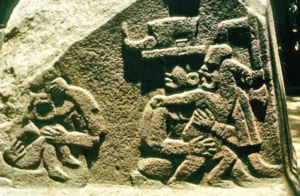Newly recovered reliefs both show a face with their arms crossed. Symbols also appear at the sides of the reliefs.

Two reliefs from the Olmec civilization were discovered by archaeologists from the Tenosique-based National Institute of Anthropology and History (Spanish: El Instituto Nacional de Antropologia e Historia, or INAH) in the Mexican state of Tabasco, the institute reported on Friday.
Both artifacts represented local rulers dating back to 900-400 BC of the Middle Usumacinta region, located between the Chacamax River and the San Pedro River, which is also where archaeologists determine the reliefs originate from, according to Heritage Daily.
Both also have a diameter of approximately 1.4 meters. Each one also weighs about 700 kilograms.
The reliefs are sculpted similarly, with both showing a face with their arms crossed. Symbols also appear at the sides of the reliefs.
How were they found and where will they go?
Carlos Arturo, the director of the INAH Tabasco Center, Carlos Arturo, said that the sculptures were recovered due to a report made by a researcher from the Center for Mayan Studies in 2019.
The reliefs were transferred to the Pomona Site Museum.
